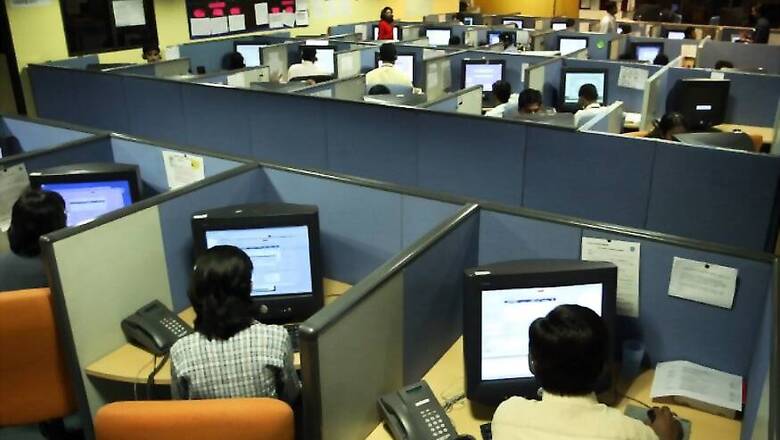
views
New Delhi: Ahead of 2019 polls, the Narendra Modi government is introducing a quarterly employment survey data, based on the new periodic labour force surveys (PLFS) conducted by the statistics department, in December.
A government-run technical committee has been formed under former chief statistician TCA Anant to bring in more transparency in jobs data calculation and presentation. The panel also has former vice-chairman of NITI Aayog Arvind Panagariya, Labour Secretary Sathiyavathy, NITI Aayog’s Pulak Ghosh and Reserve Bank of India (RBI) Board Member Manish Sabharwal as members.
The PLFS taskforce was set up by the Prime Minister’s Office in 2016 to recommend ways to get timely and reliable data on employment.
Statistics and programme implementation minister, Sadananda Gowda, said the groundwork for PLFS has been completed.
Launched in April 2017 to obtain employment data at shorter intervals, PLFS will measure quarterly changes in urban employment and annual changes in employment in both rural and urban areas.
The nodal agency, the National Sample Survey Office (NSSO), is for the first time using the computer-assisted personal interviewing method to capture data on tablets.
The ministry had put out a tender for nearly 800 tablets last year, which will be used for data collection. The tablets will also have in-built data validation rules to speed up the process. Sources in the ministry informed that they want to ensure that results of the survey are released quickly. Earlier, the NSSO used paper questionnaires for the cross-country employment survey.
Typically, NSSO surveys are carried out over at least a year’s time and the detailed report of the survey takes at least another year to compile.
But given that employment trends can change in a matter of months, the government is keen to put out the results of the quarterly PLFS at the earliest.
To tide over the manpower paucity at the NSSO, the Ministry has also hired over 700 field staff on contract, including 612 field investigators, to carry out the survey.
The Centre has outlined four major criteria by which a person may be considered unemployed or underemployed. According to the PFLS, a person will be judged unemployed if:
* He/she is occupied during the year for a number of hours less than optimal hours specified by the PFLS or,
* He/she earns an income per year less than the desirable minimum as per the PFLS or,
* He/she is willing to do more work than the one involved in at present. The person may either be actively searching for more work or be available for more work if it’s offered on terms to which one is accustomed or,
* He/she is removed from the present employment in the sense that the contribution to output is less than some normal productivity and the removal will not affect the organisation's output.
The category has been further divided into idle, poor, willing, idle and poor, idle and willing, poor and willing, idle and poor and willing.
"It (the ministry) would like to present a proper perspective on these issues so that the end users and public at large become aware of the processes involved in generation of these estimates,” said a government statement issued earlier this year.
India’s first computer based employment-unemployment survey detailing the country’s wage structure at the national and regional level will take into account 8,000 villages and 5,000 units across urban centres.
Statistics ministry, which began collecting data for the PLFS last year, plans to publish the national composite employment numbers for the July 2017-June 2018 period.
At present, the only employment data available are through NSSO surveys which are done once every five years.
The lack of frequent and regular estimates on employment and unemployment in the country is considered a major handicap by policymakers and private sector analysts alike, who find it difficult to calculate the impact of policies on the real-time job market.
The labour market also needs other forms of data, particularly, those from employing establishments on things like payrolls, social security systems and provident fund. The panel is looking at all of these data sources.
Pointing out the pain points in state-run jobs data, Arvind Panagariya had last year said, “The 10 million people entering the workforce every year number is incorrect, although it has been quoted by many and perhaps I may have used it earlier too.”
NITI Aayog Member Bibek Debroy also pointed out that there are no good data on jobs. “We will begin to have good data from 2018 because the NSS will start a survey,” he said.
“Labour and employment growth is an issue,” Debroy said, adding that there are many related issues such as growth. “The more serious issue is the breaking down of the correlation between education and skills and getting a salary which is commensurate with the skills,” he added.
The Statistics Ministry is also preparing to revise the base year of national accounts from 2011-12 to 2017-18, given the completion of the household consumer expenditure survey and the labour force survey at the end of 2018.
The data will be collected from large and small enterprises and promises to measure informal sector activity as well.
The Periodic Labour Force Survey will also incorporate a Computer Assisted Personal Interviewing (CAPI) method, with field operators using tablets to enter the data. This would generate more accurate and timely information, Mr Gowda said.
“The base year can be changed once the results of the employment survey and household consumer expenditure survey come out,” TCA Anant said. “Those are critical inputs in the base revision.”
The Ministry of Statistics is also working on a fact sheet on the Indian economy, incorporating inputs from all important ministries on 100 indicators. It is also considering an Annual Survey of Services, along the lines of the Annual Survey of Industries already being carried out.
(This story is part of News18 series #onthejob)




















Comments
0 comment